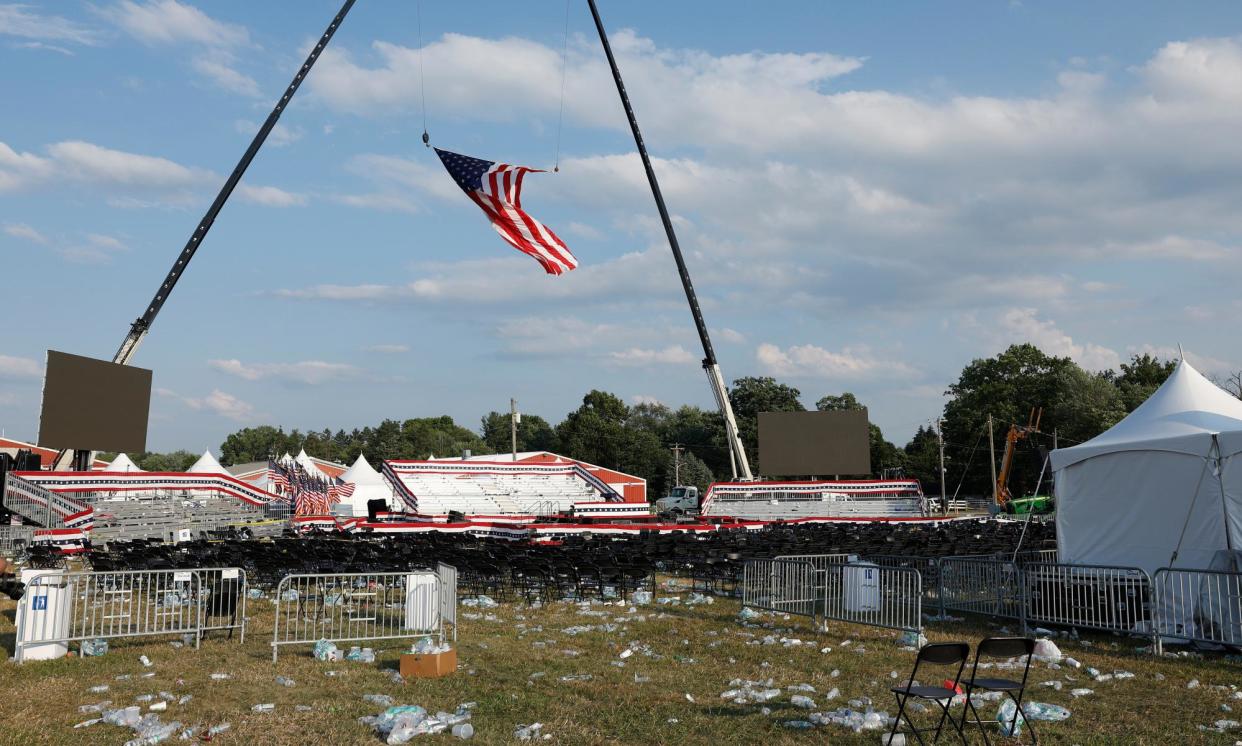Cool heads needed as political fringe dwellers spread disinformation after Trump shooting

Disinformation researcher Amanda Rogers has described the polarized, unhinged, conspiracy-driven noise in social media responses to the shooting of Donald Trump as “a self-sustaining spiral of shit”.
Rogers, a fellow at the progressive thinktank Century Foundation, has seen this before. But the scale is new and troubling, she said. Conversation on social media – and the mainstream media – is focused on the motivations of the shooter and the impact on the election, she said. Bad actors want to turn a moment like this into a broader call for violence. And they will spread lies to get there, she said.
Related: What we know about the shooting at a Donald Trump rally
“The fact that this is the perfect storm environment for dis-info from every single point on the political spectrum, is something that worries me immensely,” Rogers said. “Because it’s an accelerationist’s wet dream … But we need to have voices in the media that are speaking to the fact that this is a breaking situation. People need to calm down about speculation.”
Accelerationists are those on the political fringes – right and left – who want a civil war to burn the country to ash so they can start anew from the rubble. Notably, the term “Civil War” began trending in the wake of the Trump shooting.
Social media was instantly flooded with hyperbole, lies, conspiracy theories and uninformed nonsense about the shooting. The commentary ranged from suggestions on the right like those of Georgia representative Michael Collins that the president, Joe Biden, solicited the violence and should be charged with a crime, to those on the left suggesting that the shooting is a hoax meant to bolster Trump’s flagging poll figures.
Reasonable questions about whether the Secret Service missed something become conspiracies about whether Biden deliberately withheld competent protection for Trump, said Jonathan Corpus Ong, a disinformation researcher and professor of communications at the University of Massachusetts Amherst.
“I think it’s normal for people to be speculating, and kind of like trying to make sense of what happened,” he said. “I think it’s important for any journalist or any reader to be very critical of what they see in the media and what they’re reading, to take it slow as well … I think we would not want to be swept up with fear, because that would get us into a state of distrust in other people as well. It’s important to be vigilant with what we consume, and also learn when to step back from fear-mongering narratives.”
Factchecking the deep fakes
AI further complicates the reaction to breaking news events.
Some images from the event are bound to become iconic, like the photograph taken by Evan Vucci of the Associated Press of Trump, fist raised and ear bloodied, an American flag waving behind him as Secret Service officers sweep him from the area.
But others from questionable sources could be swiftly fabricated. There’s value in comparing pictures from multiple sources at the event, or noting which agencies are distributing them, Ong said.
“You would like to see videos and a news account and analysis, to have multiple sources and to be corroborated and verified by multiple experts, in order to make sure that it is authentic in the age of deep fakes,” he said.
The emotional, historic nature of the moment lends itself to manipulation confirming existing biases, “that trigger very strong emotions of fear or anxiety,” Ong said. “I think that’s what we need to be looking at. And be wary of.”
Related: Donald Trump rally shooting: world leaders condemn political violence
Before the FBI had identified 20-year-old Thomas Matthew Crooks as the “subject involved” in the shooting, speculation about the gun and the identity of the alleged shooter had begun. Posts began moving through social media almost immediately, suggesting that the shooter used a BB gun, or alternatively that the weapon was a “ghost gun” built from 3D-printed parts.
Police later said they recovered an AR-style rifle at the scene.
Neither claim could be immediately substantiated. Each claim serves a partisan narrative, either that the shooting was a hoax or evidence of lax gun regulations.
Similarly unsubstantiated noise emerged from rightwing spaces about the identity of the alleged shooter.
“These are the usual responses that we get from the accelerationists in the far-right channels … you’ve got people identifying the shooter as antifa, or as a trans person, as a Jewish person,” Rogers said. “You’ve got the usual suspects being trotted out. And then on the more QAnon channels you’ve got ‘this is the left trying to bait us into a civil war’.”
The one thing Rogers found most disturbing was a pattern of mass deletion of posts in the far-right Telegram channels she follows in the minutes after the shooting. She said they do that in case it was one of their own.
“Telegram aficionados know that people are watching and potentially, if there was a connection, if there’s anybody on there that did actually have facts, it’s not like they’re going to let that stuff stand.”
